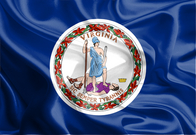Virginia General Assembly rolls up its sleeves

Virginia flag image from Shutterstock.com.
Virginia’s 2014 General Assembly is officially in session. As usual, there are plenty of proposed bills that could affect urban areas. Here are some of the key ones to follow.
Bills that look promising:
- SB97, requiring car drivers to leave three feet of clearance when passing a bicyclist.
- HB761, allowing local governments to hire transit fare inspectors and to collect fines from fare violators. This will be necessary for any future streetcars that use a proof of payment fare structure.
- HB626, changing the formula used to distribute transportation funds around the state, eliminating a provision that took $500 million off the top and allocated it to highways.
- SB320, sponsored by Adam Ebbin (D-Arlington), allowing jurisdictions in Northern Virginia to implement plastic bag fees.
- HB212, prohibiting drivers from holding pets while driving.
- HB482, making failing to wear a seatbelt a primary offense, allowing police to stop and ticket people for that alone.
Bills that look troubling:
- HB2, limiting transportation funding going to the Northern Virginia and Hampton Roads construction districts to only projects that reduce highway congestion. Safety projects, maintenance projects, many transit and bike/ped projects, and just about everything else would be excluded.
- HB40, HB41, HB425, HB635, and several others that all seek to reduce Northern Virginia’s authority to build its own transportation projects, especially transit.
- HB426, requiring VDOT to widen I-66 in Arlington.
- HB281, restricting Northern Virginia from partnering with DC or Maryland on transportation projects, unless the costs are born exactly equally.
- HB160, giving courts authority to reduce charges currently defined as “reckless driving” to merely “speeding.”
- HB792, requiring Northern Virginia communities to rewrite their zoning ordinances to restrict the number of housing units smaller than 500 square feet.
- HB908, defining Uber as a “contract passenger carrier” rather than a taxicab, effectively removing any ability of localities to regulate it.
Other bills of interest:
- HB870, providing a tax credit to companies that build their own infrastructure, including new roads.
- SB505, a huge bill enacting a broad range of incentives for the use of natural gas as a transportation fuel.
- HB560, allowing VDOT to grant Right of Way (ROW) permits to certain types of private companies, instead of only to public utilities.
- HB691, creating a “Prince William Metrorail Improvement District,” to begin the process to extend Metro into Prince William County.
- SB156, requiring that either toll rates for E-ZPass users and non-E-ZPass users be set the same, or requiring the operator of a toll road to pay the annual fee for all E-ZPass users living within 50 miles of a toll road. This bill comes from Senator John Miller of the Hampton Roads area, where they are debating controversial proposals to let private operators collect tolls in exchange for rebuilding tunnels. But if the law passes it would also include much of Northern Virginia.
- SB1, from Adam Ebbin again, that would repeal a higher tax on hybrid-electric cars. The tax was originally imposed to make up for such cars contributing less to the gas tax. Ebbin questions whether taxing more efficient vehicles is the best way to solve that issue.
- HB122, defining three-wheeled mini cars that kind of look like hardcore golf carts with bigger engines as “autocycles” and regulating them in various ways. It’s not a coincidence that this bill comes from Edward T. Scott, delegate from the very district that’s home to the first autocycle manufacturing plant in the US.
- HB475, legalizing pedestrians stepping into the roadway to solicit charitable contributions.
- HB255, requiring red light cameras to have yellow light phases lasting at least three seconds.
It’s going to be an exciting year, with numerous bills to root both for and against. There are also a lot of bills about the Northern Virginia Transportation Authority and how Virginia will allocate the money from last year’s transportation funding deal. We’ll talk about those next week.
